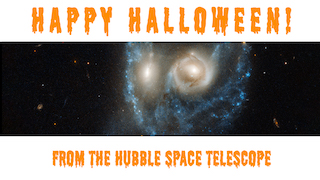A New Dawn
The fate of the Milky Way is certain: Six billion years from now it will merge with the Andromeda galaxy. The prediction is based on images taken by NASA's Hubble Space Telescope. By examining the position of stars in Andromeda—located 2.5 million light-years away—scientists were able to calculate its movement through space. Traveling at 250,000 mph, the neighboring giant spiral is scheduled to make a head-on encounter with our galaxy about 4 billion years from now. Subsequent clashes over 2 billion years will give rise to a combined elliptical galaxy, replete with stars scattered in new orbits. It seems Earth, the sun and planets in our solar system will survive the crash but take on new coordinates in the cosmos. The video and computer simulation detail the structural evolution of the Milky Way and Andromeda leading up to the birth of a new galaxy.

The Milky Way and Andromeda galaxies are destined to collide. See how it will all unfold.
Watch this video to learn more about what will happen when the two galaxies collide.
This computer simulation shows the Milky Way and Andromeda as their orbits evolve over the next 7 billion years.

The following illustrations preview the merger as seen from Earth, beginning with a present day view of Andromeda and the Milky Way (above).

At 2 billion years, the mutual pull of gravity between the two galaxies brings Andromeda closer, increasing its visibility.

At 3.75 billion years, Andromeda and the Milky Way prepare for their initial collision.

At 3.85 billion years, the sky brightens from the emergence of newly formed stars.

At 3.9 billion years, clouds of ionized gas fill the sky.

At 4 billion years, the Milky Way appears warped and Andromeda stretched following their first encounter.

At 5.1 billion years, the cores of the Milky Way and Andromeda appear as a pair of bright lobes.

At 7 billion years, the two galaxies combine and form a huge elliptical galaxy.
For More Information
See Science@NASA
Credits
Please give credit for this item to:
Science@NASA, Space Telescope Science Institute (STScI) and NASA's Goddard Space Flight Center
Galaxy illustrations courtesy of NASA, ESA, Z. Levay and R. van der Marel (STScI) T. Hallas, and A. Mellinger
Visualization courtesy of NASA, ESA, and F. Summers (STScI)
Simulation courtesy of NASA, ESA, G. Besla (Columbia University) and R. van der Marel (STScI)
-
Writer
- Kayvon Sharghi (USRA)
Release date
This page was originally published on Thursday, July 12, 2012.
This page was last updated on Wednesday, May 3, 2023 at 1:52 PM EDT.
